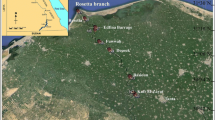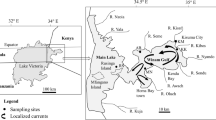Abstract
The aim of this study was to investigate seasonal heavy metal accumulation and translocation characteristics of the narrow-leaved cattail (Typha angustifolia L.). Sediment and plant samples were taken seasonally from six different locations identified for this purpose, and Pb, Cr, Cu, Ni, Zn, and Cd concentrations as well as accumulation factor (AF) and translocation factor (TF) values were determined. It was noted that the metal concentrations in the plant roots, rhizomes, and leaves differed seasonally. The metals mainly accumulated in the plant roots, and Zn was the element that accumulated the most in the plant roots, rhizomes, and leaves. The highest Zn concentration was observed to be 56.47 μg g−1 in the rhizome sample from the summer. In all the seasons, the AF value of Cd was observed to be above 1. In addition, the TF value was below 1 for all elements in every season. While the element having lowest uptake and translocation ratio was Cr, and the highest uptake and translocation ratio was found for Cd. The AF and TF values suggest that the plant would be most appropriate for use in phytostabilization.









Similar content being viewed by others
References
Aken BV, Correa PA, Schnoor JL (2010) Phytoremediation of polychlorinated biphenlys: new trends and promises. Environ Sci Technol 44:2767–2776. doi:10.1021/es902514d
Aksoy A, Duman F, Sezen G (2005) Heavy metal accumulation and distribution in narrow-leaved cattail (Typha angustifolia) and common reed (Phragmites australis). J Freshw Ecol 20:783–785. doi:10.1080/02705060.2005.9664806
Ali H, Khan E, Sajad MA (2013) Phytoremediation of heavy metals-concepts and applications. Chemosphere 91:869–881. doi:10.1016/j
Bah AM, Dai H, Zhao J, Sun H, Cao F, Zhang G, Wu F (2011) Effects of cadmium, chromium and lead on growth, metal uptake and antioxidative capacity in Typha angustifolia. Biol Trace Elem Res 142:77–92. doi:10.1007/s12011-010-8746-6
Bonanno G (2013) Comparative performance of trace element bioaccumulation and biomonitoring in the plant species, Typha domingensis, Phragmites australis and Arundo donax. Ecotoxicol Environ Saf 97:124–130. doi:10.1016/j.ecoenv.2013.07.017
Bonanno G, Giudice RL (2010) Heavy metal bioaccumulation by the organs of Phragmites australis (common reed) and their potential use as contamination indicators. Ecol Indic 10:639–645. doi:10.1016/j.ecolind.2009.11.002
Brankovic S, Pavlovic-Muratspahic D, Topuzovic M, Glisic R, Bankovic D, Stankovic M (2011) Environmental study of some metals on several aquatic macrophytes. Afr J Biotechnol 10:11956–11965. doi:10.5897/AJB10.2655
Brekken A, Steinnes E (2004) Seasonal concentrations of cadmium and zinc in native pasture plants: consequences for grazing animals. Sci Total Environ 326:181–195. doi:10.1016/j.scitotenv.2003.11.023
Cardwell AJ, Hawker DW, Greenway M (2002) Metal accumulation in aquatic macrophytes from southeast Queesland, Australia. Chemosphere 48:653–663. doi:10.1016/S0045-6535(02)00164-9
Chandra R, Yadav S (2010) Potential of Typha angustifolia for phytoremediation of heavy metals from aqueous solution of phenol and melanoidin. Ecol Eng 36:1277–1284. doi:10.1016/j.ecoleng.2010.06.003
Chandra R, Yadav S (2011) Phytoremediation of Cd, Cr, Cu, Mn, Fe, Ni, Pb and Zn from aqueous solution using Phragmites communis, Typha angustifolia, Cyperus esculentus. Int J Phytorem 13:580–591. doi:10.1080/15226514.2010.495258
Das M, Maiti SK (2007) Metal accumulation in 5 native plants growing on abandoned Cu-tailings ponds. Appl Ecol Environ Res 5:27–35. doi:10.15666/aeer/0501_027035
Demirezen Yılmaz D, Aksoy A (2004) Accumulation of heavy metals in Typha angustifolia (L.) and Potamogeton pectinatus (L.) living in Sultan Marsh (Kayseri, Turkey). Chemosphere 56:685–696. doi:10.1016/j.chemosphere.2004.04.011
Drzewiecka K, Borowiak K, Mleczek M, Zawada I, Golınskı P (2010) Cadmium and lead accumulation in two littoral plants of five lakes in Poznan, Poland. Acta Biol Cracov Ser Bot 52:59–68. doi:10.2478/v10182-010-0024-6
Duman F (2001) Determination of heavy metal levels of Phragmithes australis and Typha angustifolia growing at Sarimsakli-Karasu and sediment samples. Dissertation, University of Erciyes.
Duman F, Urey E, Kar M (2013) Temporal variation of metal concentrations of creek sediment samples. Pol J Environ Stud 22:1335–1339
Farooq MA, Ali S, Hameed A, Ishaque W, Mahmood K, Iqbal Z (2013) Alleviation of cadmium toxicity by silicon is related to elevated photosynthesis, antioxidant enzymes; suppressed cadmium uptake and oxidative stress in cotton. Ecotoxicol Environ Saf 96:242–249. doi:10.1016/j.ecoenv.2013.07.006
Ganjo DGA, Khwakaram AI (2010) Phytoremediation of wastewater using some of aquatic macrophytes as biological purifiers for irrigation purposes. World Acad Sci Eng Technol 4:1409–1432
Hegazy AK, Abdel-Ghani NT, El-Chaghaby GA (2011) Phytoremediation of industrial wastewater potentiality by Typha domingensis. Int J Environ Sci Tech 8:639–648
Hozhina EI, Khramov AA, Gerasimov PA, Kumarkov AA (2001) Uptake of heavy metals, arsenic, and antimony by aquatic plants in the vicinity of ore mining and processing industries. J Geochem Explor 74:153–162. doi:10.1016/S0375-6742(01)00181-9
Jiang X, Teng A, Xu W, Liu X (2014) Distribution and pollution assessment of heavy metals in surface sediments in the Yellow Sea. Mar Pollut Bull 83:366–375. doi:10.1016/j.marpolbul.2014.03.020
Kim ND, Fergusson JE (1994) Seasonal variations in the concentrations of cadmium, copper, lead and zinc in leaves of the horse chestnut (Aesculus hippocastanum L.). Environ Pollut 86:89–97
Klink A, Wislocka M, Musial M, Krawczyk J (2013) Macro- and trace-elements accumulation in Typha angustifolia L. and Typha latifolia L. organs and their use bioindication. Pol J Environ Stud 22:183–190. doi:10.1016/j.limno.2012.08.012
Macfarlane GR, Burchett MD (2001) Photosynthetic pigments and peroxidase activity as indicators of heavy metal stress in the grey mangrove, Avicennia marina (Forsk.) Vierh. Mar Pollut Bull 42:233–240. doi:10.1016/S0025-326X(00)00147-8
Majid SN, Khwakaram AI, Rasul GAM, Ahmed ZH (2014) Bioaccumulation, enrichment and translocation factors of some heavy metals in Typha angustifolia and Phragmites australis species growing along Qalyasan Stream in Sulaimani City/IKR. JZS-A 16:93–109
Memon AR, Aktopraklıgil D, Özdemir A, Vertıı A (2001) Heavy metal accumulation and detoxification mechanisms in plants. Turk J Bot 25:111–121
Miloskovic A, Brankovic S, Simic V, Kovacevic S, Cirkovic M, Manojlovic D (2013) The accumulation and distribution of metals in water, sediment, aquatic macrophytes and fishes of the Gruza Reservoir, Serbia. Bull Environ Contam Toxicol 90:563–569. doi:10.1007/s00128-013-0969-8
Nouri J, Lorestani B, Yousefi N, Khorasani N, Hasani AH, Seif F, Cheragi M (2011) Phytoremediation potential of native plants grown in the vicinity of Ahangaran lead-zinc mine (Hamedan, Iran). Environ Earth Sci 62:639–644. doi:10.1007/s12665-010-0553-z
Prado C, Rosa M, Pagano E, Hilal M, Prado FE (2010) Seasonal variability of physiological and biochemical aspects of chromium accumulation in outdoor-grown Salvinia minima. Chemosphere 81:584–593. doi:10.1016/j.chemosphere.2010.08.033
Prasad MNV (2003) Phytoremediation of metal-polluted ecosystems: hype for commercialization. Russ J Plant Physiol 50:764–780. doi:10.1023/A:1025604627496
Sasmaz A, Obek E, Hasar H (2008) The accumulation of heavy metals in Typha angustifolia L. grown in a stream carrying secondary effluent. Ecol Eng 33:278–284. doi:10.1016/j.ecoleng.2008.05.006
Yadav S, Chandra R (2011) Heavy metals accumulation and ecophysiological effect on Typha angustifolia L. and Cyperus esculentus L. growing in distillery and tannery effluent polluted natural wetland site, Unnao, India. Environ Earth Sci 62:1235–1243. doi:10.1007/s12665-010-0611-6
Author information
Authors and Affiliations
Corresponding author
Additional information
Responsible editor: Elena Maestri
Rights and permissions
About this article
Cite this article
Duman, F., Urey, E. & Koca, F.D. Temporal variation of heavy metal accumulation and translocation characteristics of narrow-leaved cattail (Typha angustifolia L.). Environ Sci Pollut Res 22, 17886–17896 (2015). https://doi.org/10.1007/s11356-015-4979-4
Received:
Accepted:
Published:
Issue Date:
DOI: https://doi.org/10.1007/s11356-015-4979-4




